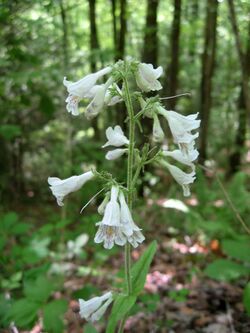Biology:Penstemon brevisepalus
| Penstemon brevisepalus | |
|---|---|

| |
| Scientific classification | |
| Kingdom: | Plantae |
| Clade: | Tracheophytes |
| Clade: | Angiosperms |
| Clade: | Eudicots |
| Clade: | Asterids |
| Order: | Lamiales |
| Family: | Plantaginaceae |
| Genus: | Penstemon |
| Species: | P. brevisepalus
|
| Binomial name | |
| Penstemon brevisepalus Pennell
| |
Penstemon brevisepalus, commonly known as short-sepaled beardtongue,[1] is an herbaceous plant in the plantain family. It is a perennial that produces pale lavender flowers in late spring.
It is native to the eastern United States, where it is restricted to the states of Kentucky, Tennessee , Virginia, and West Virginia. Its natural habitat is acidic woodlands, prairies, and rock outcrops (typically sandstone or shale).[2]
This species was described to science in 1933 by botanist Francis W. Pennell, although it was subsequently included under Penstemon canescens or Penstemon pallidus in later 20th century treatments.[2] More recent botanists have elevated it back to the species level due to its morphological distinction and well-defined geographic range.
References
- ↑ Flora of the Southern and Mid-Atlantic States by Alan Weakley, 2015
- ↑ 2.0 2.1 Chester, Edward (2015). Guide to the Vascular Plants of Tennessee.
Wikidata ☰ Q15351664 entry
 |

